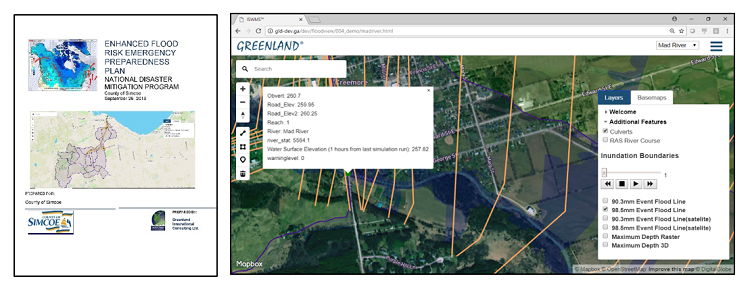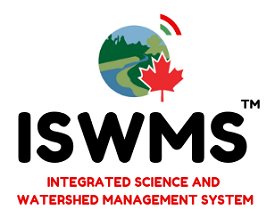Latest Evolution (Year 2020 and Beyond)
ISWMS™ (Version ‘2’) is a fully functional web-based / open source GIS system for forecasting and visualizing flood extents in watersheds anywhere in Canada. ISWMS™ (v.2) automatically gathers Environment Canada open climate forecast databases (deterministic) and feeds them into sophisticated and computationally demanding hydrologic and hydraulic models to develop deterministic forecasts of water levels and inundation.
ISWMS™ (v.2) is deployed on a cloud (but is executed in serial-mode) and runs periodically (within hours) to develop flood forecasts for interactive web-based visualization and flood mitigation decision support. Also, given the Platform’s integration with HEC-HMS (hydrologic) and HEC-RAS (hydraulic) analytical models, ISWMS™ (v.2) has these unique attributes to:
In January 2020, and part-of a multi-year software collaboration, GREENLAND® and University of Guelph (Canada), began the development of the next IoT Platform version of ISWMS™.
This research intends to develop a modeling extension that will allow ISWMS™ (v.2) to: 1) run efficiently on parallel compute clusters; and, 2) incorporate uncertainties associated with climate forecasts into flood extent forecasts of ISWMS™. This ISWMS™ Version ‘3’ is also referred to as “ISWMS™ - Smart”. Our team has also successfully leveraged parallel computing (via a prior project for CANWET™ and with deployment on a Cloud Analytics Platform) in developing an efficient web-based platform for calibration of hydrologic models. Our team intends to build upon this niche expertise and knowledge attained in the past software collaborations and to develop the first ISWMS™ - Smart prototype in 2020.
ISWMS™ - Smart will quantify any uncertainties in ISWMS™ (v.2) flood forecasts originating from the uncertainties inherent in the climate forecasts, by enabling ISWMS™ to run in parallel for different climate forecast scenarios. Therefore, a critical need for successful development of ISWMS™ - Smart is the development and testing of a parallel programming infrastructure for ISWMS™ to improve its efficiency. Consequently, the research pertaining to development of ISWMS™ - Smart requires continuous access to compute clusters designated for developing innovating computing solutions to complex problems. Moreover, ISWMS™ - Smart will include AI-based (machine learning) algorithms designed to optimize the use of computing resources during parallel runs of any ISWMS™ - Smart hydrologic and hydraulic models. Hence, secure (continuous) access to advanced computing resources will also be implemented to confirm the effectiveness of the new algorithms. This will also be key for future contractual partnerships too.

Spatial-temporal resolution and complexity of earth data and human-environment interactions is continuously increasing, and demanding an improvement in complexity and efficiency of flood forecasting decision support systems. ISWMS™ - Smart will significantly improve the capability (by quantifying forecast uncertainty) and efficiency (via parallelization) of ISWMS™, allow the ISWMS™ decision support system to run on large watersheds, and consequently increase the applicability of the platform for new clients. Moreover, the computational efficiency of ISWMS™ - Smart also intends to reduce operational costs (of cloud computing services). Therefore, this next evolution of ISWMS™ will also be a “disruptive market advantage” for GREENLAND®.
ISWMS™: Background (2000 - 2019)
In 2000, the first Integrated Science and Watershed Management System (ISWMS™) tool was completed by GREENLAND® as a windows-based ‘SWMM and OTTHYMO’ – based decision support system for urban land stormwater management; hydrological (continuous rainfall and design storm events) modelling; and, Canadian flood forecasting capabilities.
In 2003, GREENLAND® was retained to develop ISWMS™ (Version ‘1’) as a flood forecasting system for the 3,360km² Nottawasaga River Basin, located north of Toronto (Canada). It was then used for many years thereafter to prepare Subwatershed Management Plans in Ontario. In 2006, GREENLAND® began working on the next ISWMS™ (v.1) phases, including an open source GIS operational platform that was developed for a daily water balance, nutrient and sediment loading tool (CANWET™).
In 2010, the ISWMS™ program added new technical support partners affiliated with Canadian and U.S. universities. These independent scientists would later on assist GREENLAND® as a “science advisory team” for engineering projects that also used the company’s in-house tools.
In 2016, GREENLAND® formed a strategic alliance in Europe with private and public sector teams from Sweden and France and to initiate a new IoT Platform partnership. The initial goal was to develop a cloud-based flood forecasting, flood control and floodplain mapping system (called ISWMS™ - Version ‘2’) for watershed managers and regulatory agencies. The first collaboration was completed in 2019 and where the new web-based tool is being used now in Canada to identify real-time solutions that can minimize mixed rural & urban watershed flood damages and help prevent loss of life from flood disasters. This platform was also developed for use anywhere else in the world. It includes an early warning flood forecasting system that requires powerful visualization connected to the latest (public domain) versions of HEC-HMS and HEC-RAS that are developed /maintained by the U.S. Army Corps of Engineers.

Development of the ISWMS™ Platform relied on other proprietary GREENLAND® hydrology and stormwater management modelling tools. The GREENLAND® (Canada-Europe) team consulted also with property-casualty insurers in order to develop an open/transparent system framework that could also address climate impact concerns. Other Canada-based partners included the County of Simcoe (Ontario); University of Guelph; Communitech Corporation; First Nations; and, University of Waterloo Interdisciplinary Centre on Climate Change (IC3) and Partners for Action (P4A) network. Finally, the U.S. software engineering firm ‘Civil-GEO’ was consulted on the project too. In late 2019, the GREENLAND® team (and also with the University of Guelph) secured new leverage funding to continue the ISWMS™ IoT Platform development program. In the meantime, GREENLAND® continues to use ISWMS™ (v.2) as a “free licensed asset” for its consulting client contracts (private and public sectors), and for new collaborations supported by Canada’s National Flood Damage Reduction Program, as well as future Smart Cities & Climate Change Adaptation - Protection Programs.

Town of The Blue Mountains
On behalf of the Town of The Blue Mountains, we would like to thank you and your organization for your specialized technical support in a peer review capacity over the past four years… Your team not only provided timely review of all drainage related features of development applications but introduced updated municipal design criteria addressing changing climatic conditions. By unraveling the weather factors that impact snow melt potential, your team has helped the Town better understand how to be proactive in developing sustainable infrastructure.
Your team’s support assisted in keeping Town’s development projects moving forward efficiently. In addition to this, the review and introduction of updated municipal design criteria and construction standards addressing changing climatic conditions, continues to ensure the Town of The Blue Mountains fulfills its mandate for sustainable development.
Reg Russwurm MBA, P. Eng.
Director of Engineering and Public Works
Town of The Blue Mountains
February 3, 2014
Six Nations of the Grand River
On behalf of the Public Works Office of the Six Nations of the Grand River, we would like to thank Greenland International Consulting Limited for the work completed to prepare the Master Drainage and Flood Remediation Plan (MDFRP) for both the Boston Creek and Rogers Creek subwatersheds, as well as the McKenzie Creek Subwatershed. These findings have enabled our office to identify all flood prone residences, building structures and other infrastructure throughout these subwatersheds with the flood plain mapping that has been prepared as part of this assignment.
Greenland has been integral to assisting our Office with identifying and prioritizing the remedial projects to mitigate flooding in the McKenzie, Boston and Rogers Creek subwatersheds that flow through our Community. We also appreciate Greenland's effort in assisting the Six Nations of the Grand River with the preparation of funding applications to secure the resources to complete these remedial works. We are convinced that this MDFRP completed for McKenzie Creek, Boston Creek and Rogers Creek can be used as a template for completing similar drainage and flood remediation works both locally and in other First Nations.
Michael R. Montour
Director of Public Works
Six Nations of the Grand River
December 2, 2019
NRC-IRAP
I am writing to acknowledge the completion of a successful R&D project funded by the National Research Council’s Industrial Research Assistance Program (NRC-IRAP).
Your firm’s performance on the project was excellent, and your team was a pleasure to work with.
The CANWET product that you have commercialized since the end of the project represents a strong step forward in your field, and you should be proud.
We wish you well in the successful commercialization of the technology, and the continued growth of your firm which will contribute to the Canadian economy.
Doug Reed
Industrial Technology Advisor
NRC-IRAP
July 8, 2011